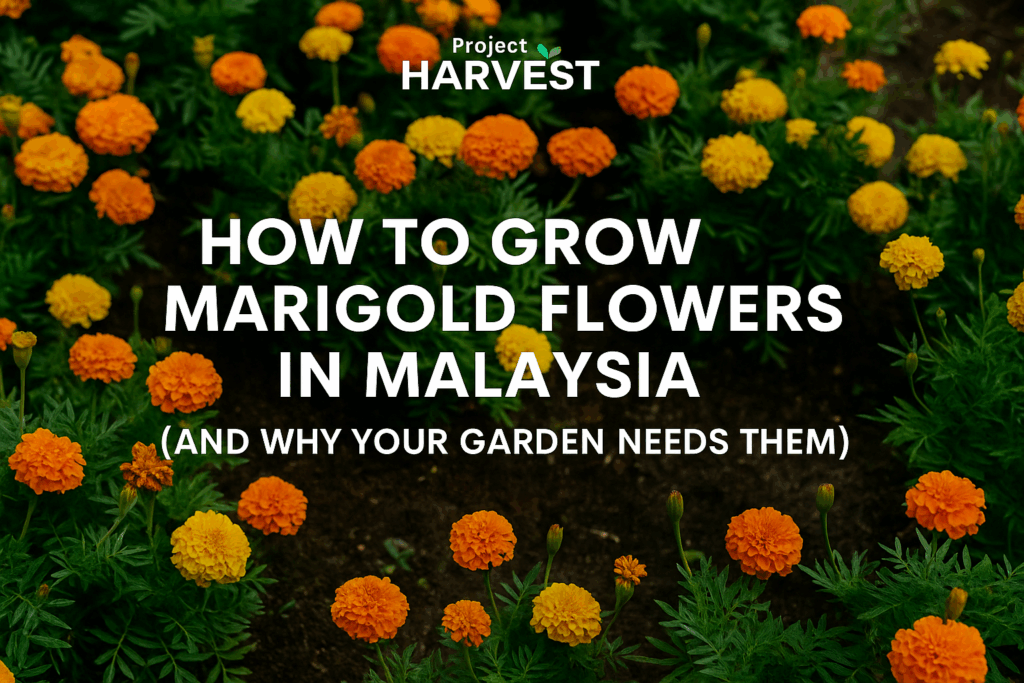🌼 Why Marigolds Deserve a Spot in Every Malaysian Garden
With their fiery shades of orange and yellow, marigolds—known locally as bunga tahi ayam—are not only eye-catching, but also incredibly practical. Whether you’re gardening on a condo balcony or tending to a kampung plot, these hardy blooms bring a blend of beauty, utility, and tradition to your outdoor space.
🌞 Perfect Match for Malaysian Climate
Marigolds thrive in Malaysia’s hot and humid climate. They’re sun-lovers, able to handle intense tropical rays, and they’re relatively drought-tolerant once established. Whether in Petaling Jaya or Penang, these flowers will flourish with very little fuss.
🐛 Natural Pest Repellent
Think of marigolds as your garden’s security system. They release a strong scent that repels pests like:
- Aphids
- Mosquitoes
- Whiteflies
- Nematodes in the soil
You’ll often see marigolds planted alongside vegetables like tomatoes and chillies to protect them—an age-old companion planting technique that’s gaining popularity again among urban and traditional gardeners alike.
🐝 Attracts Pollinators
Want more bees and butterflies in your garden? Marigolds are magnets for pollinators. This increases the success of fruiting plants around them (like lime, eggplants, and papaya), and helps support local ecosystems.
✨ Cultural & Spiritual Value in Malaysia
Marigolds are frequently used in:
- Hindu and Buddhist religious ceremonies
- Decorations for weddings and festivals like Deepavali and Thaipusam
- Traditional remedies (the petals are used in infusions for skincare and wounds)
So, you’re not just planting a flower—you’re growing a cultural icon.
🧑🌾 How to Grow Marigolds in Malaysia
Step 1: Choose the Right Variety
- French Marigold (Tagetes patula) – Compact, bushy, great for pots
- African Marigold (Tagetes erecta) – Taller with larger blooms
- Signet Marigold (Tagetes tenuifolia) – Smaller, edible flowers
💡 French marigolds are easiest for beginners.
Step 2: Start from Seeds or Seedlings
- Sow directly in well-drained soil or use seed trays
- Keep the soil moist but not waterlogged
- Germination typically takes 5–7 days
Step 3: Sunlight & Water
- Needs 6+ hours of sunlight daily
- Water when the top 2–3 cm of soil is dry
- Avoid wetting leaves to prevent fungus
Step 4: Soil & Fertilizer
- Use loamy, well-draining soil
- Add compost or organic fertilizer every 2 weeks
- Optional: Add a small amount of bone meal for stronger blooms
Step 5: Pruning & Deadheading
- Regularly snip off wilted flowers to encourage more blooms
- Lightly prune bushy varieties to control size and shape
🧪 Bonus: Companion Planting with Marigolds
Marigolds pair well with:
- Tomatoes
- Chilli
- Eggplants
- Cucumber
- Basil
Not only do they protect these crops from pests, but their bright colors also make your garden look vibrant and inviting.
🧘♀️ Fun Uses & Extra Benefits
- DIY Petal Face Mist – Infuse petals in hot water and cool for skin-soothing mist
- Dried Marigold Garlands – Used for festive decor and temple offerings
- Kid-Friendly Garden Project – Fast growth makes marigolds great for young gardeners
🌿 Final Thoughts
Marigolds are proof that something beautiful can also be incredibly useful. Whether you want a pest-free veggie garden, pollinator haven, or just a cheerful pop of color, marigolds are your low-maintenance best friend.
So go ahead—plant a few. Your garden (and your Instagram feed) will thank you. 😉 Don’t foget to tag us @projectharvest.my on IG as well.

